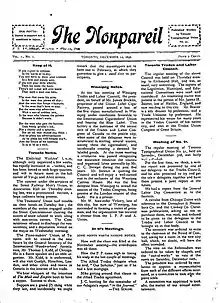Toronto Typographical Union
The Toronto Typographical Union (TTU) was an early Canadian trade union in the printing industry. Founded in 1832, it came to prominence in 1872 when it organized a major strike in Toronto. Membership declined in the mid- to late-20th century as printing turned digital. By 1994, TTU had been absorbed by the Communications, Energy and Paperworkers Union of Canada.

Origins
The association that would become the Toronto Typographical Union was first organized in 1832 as the York Typographical Union.[1][lower-alpha 1] This association, which was renamed the Toronto Typographical Society in 1835, survived only to 1837.[1] It was reorganized in 1844 to counter newspaper publisher George Brown's efforts to lower printing workers' wages.[2]
In May 1866, the then–Toronto Typographical Society joined the National Typographical Union to become, officially, Toronto Typographical Union No. 91.[3] The National Typographical Union, organized beginning in December 1850, was based in the United States.[4] Zerker argues that, as a consequence, TTU came under "foreign domination".[5] Burr suggests that this overstates the point, as TTU's members in Toronto supported its move to become a local of the American organization.[6]
1872 printers' strike
Among other activities, TTU is known for its role in organizing a strike on March 25, 1872, known as the Toronto printers' strike.[7] Historian Robert H. Babcock describes it as "one of the most important events in Canadian labour history".[8] TTU organized the strike as part of the Nine-Hour Movement for a workday of nine hours, a demand that unions in Britain and the United States (in the latter case, for an eight-hour workday), were making around the same time.[9]
TTU and the print workers it represented announced their demand for a nine-hour day, with no accompanying pay cut, on March 13, 1872.[10] Their bosses—then still known as master printers—refused the offer on March 19, with one exception.[10] James Beaty, a Conservative politician and editor of the Toronto Leader, accepted TTU's demands and even wrote in favour of their cause.[11] The strike began on March 25.[10] George Brown, publisher of The Globe (now The Globe and Mail), vehemently opposed the strike, and arranged for the arrest of its leaders.[12]
Strike supporters rallied again in large numbers at Queen's Park on April 15, 1872.[13] Twenty-three TTU organizers were arrested for conspiracy on April 16, and a trial began on April 18.[14] At the time, Canadian law made no exception for unions to the general common law rules governing the crime of conspiracy: a union committee's "conspiracy" to disrupt a commercial enterprise with a strike was no different in law from any other agreement to disturb the peace.[15] The organizers were accordingly convicted.[15]
Shortly after the Queen's Park rally, Prime Minister John A. MacDonald introduced the Trade Unions Act, 1872 in the House of Commons, which made certain forms of union activity legal. The Act was based on two statutes that had recently been adopted in Britain: the Trade Union Act 1871 and Criminal Law Amendment Act 1871.[16] It passed on June 14, 1872.[12]
Decline
The rise of computer-based printing in the 1960s and 1970s largely rendered manual typesetting obsolete. Accordingly, TTU membership declined precipitously during this period, beginning with a lengthy newspaper strike that began in 1964.[17] As of January 1978, TTU had just over 1,300 members.[18] The union was still active in Mississauga as of 1987, when it won a settlement on behalf of 30 workers at Burlington Air Express (now BAX Global) at the Ontario Labour Relations Board.[19] It had become a local of the Communications, Energy and Paperworkers Union of Canada by 1994.[20]
See also
Notes
- At that time, the city now known as Toronto was called York. It would become Toronto in 1834, just two years after the York Typographical Union was founded.
References
Footnotes
- Finkelstein 2018, p. 87.
- Finkelstein 2018, pp. 87–88.
- Kealey 1980, p. 84.
- Zerker 1982, p. 65.
- Zerker 1982.
- Burr 1993, p. 345.
- Burr 1993, p. 344.
- Babcock 1981, p. 127.
- Zerker 1982, p. 78.
- Creighton 1972, p. 180.
- Creighton 1972, pp. 181–182.
- Phillips, Pattie (September 4, 2009). "Highlights in Canadian labour history". CBC News. Retrieved December 13, 2020.
- Bradburn, Jamie (July 2, 2015). "Toronto Feature: Printers' Strike". The Canadian Encyclopedia. Archived from the original on May 11, 2020. Retrieved September 9, 2020.
- Creighton 1972, p. 184.
- Creighton 1972, p. 187.
- Creighton 1972, pp. 189–190.
- Dewalt 1995, pp. 127, 139.
- Zerker 1982, p. 316.
- The Canadian Press (November 11, 1987). "Tactic Costs Firm $400,000". The Windsor Star. p. A7. ProQuest 253669245.
- Swift, Jamie (2003). Walking the Union Walk: Stories from CEP's First Ten Years. Ottawa: Communications, Energy and Paperworkers Union of Canada. p. 111. ISBN 0-9731652-0-0. OCLC 50580865.
Bibliography
- Babcock, Robert H. (1981). "A Note on the Toronto Printers' Strike, 1872". Labour/Le Travail. 7: 127–129. doi:10.2307/25140025. JSTOR 25140025.
- Burr, Christina (September 1993). "'That Coming Curse – The Incompetent Compositress': Class and Gender Relations in the Toronto Typographical Union during the Late Nineteenth Century". Canadian Historical Review. 74 (3): 344–366. doi:10.3138/CHR-074-03-02. ISSN 0008-3755. S2CID 161537131.
- Creighton, Donald Grant (1972). Towards the Discovery of Canada: Selected Essays. Toronto: Macmillan Publishers. ISBN 0-7705-0788-3. OCLC 825443.
- Dewalt, Bryan (1995). Technology and Canadian Printing: A History from Lead Type to Lasers. Ottawa: Canada Science and Technology Museum. ISBN 0660120216. OCLC 1051179169.
- Finkelstein, David (2018). Movable Types: Roving Creative Printers of the Victorian World. Oxford: Oxford University Press. ISBN 978-0-19-882602-6.
- Kealey, Gregory S. (1980). Toronto Workers Respond to Industrial Capitalism, 1867–1892. Toronto: University of Toronto Press. ISBN 0-8020-5488-9. OCLC 6457221.
- Zerker, Sally Friedberg (1982). The Rise and Fall of the Toronto Typographical Union, 1832–1972: A Case Study of Foreign Domination. Toronto: University of Toronto Press. ISBN 978-1-4426-3292-9. JSTOR 10.3138/j.ctt15jvw33. OCLC 918589047.
External links
- "The Printers' Strike of 1872". Ontario Heritage Trust. December 8, 2016.